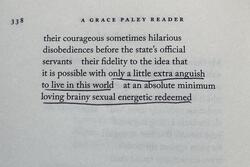Building a new social safety net: Sara Horowitz and the Freelancers Union
In 1909, Jewish women revolutionized the American labor movement. Before the huge garment industry strike known as the “Uprising of the 20,000,” union leaders saw women workers as irrelevant to the labor movement because they did not fit into the model of the traditional male union member. But these garment workers, many of them young Jewish women, proved that women could, in fact, organize effectively and challenge working conditions, and in doing so, they expanded the definition of worker and union member.
Another Jewish woman, Sara Horowitz, is doing something similar today. Born into labor activism--“My grandfather was vice president of the International Ladies Garment Workers’ Union. My father was a union-side labor lawyer, as is my husband… I grew up going to the union housing apartments, where my grandma lived”--she began working for unions at age 18. During her early career as a labor organizer and labor attorney, she began to notice that the social safety net-- designed by labor unions and implemented by FDR’s New Deal--does not protect the growing independent workforce of freelancers. Because social services such as health insurance, disability insurance, and retirement plans are traditionally organized through employers, freelancers--who currently make up more than 30% of the economy--do not have access to them.
Believing that even people who work independently should have access to mutual support, Horowitz founded the Freelancers Union so those in what she calls the new “free agent economy” could purchase group health insurance and other services (disability, life insurance) together at a better rate. Though the Freelancers Union differs from a traditional union in that it does not engage in collective bargaining for wages and does not have elected officials, it shares with other unions the goal of harnessing collective power and creating community among members, bringing freelancers together for education, networking, social activities, and political activities. Rather than representing a specific industry, membership in the union is based on a “common work arrangement” (freelancing), and members come from more than 50 industries, including television/film production, advertising, graphic design, information technology, journalism, the arts, and yoga and fitness.
In this era of political debate around the privatization of public services, the structure of the Freelancers Union (which avoids the acronym “FU” for obvious reasons) is innovative: it’s a non-profit organization with its own for-profit insurance company, which reinvests its profits into research, development, and lower insurance premiums. It’s also creating new models to serve its members. This fall, for example, it is opening Freelancers Medical, the first bricks-and-mortar primary care practice just for freelancers. The clinic will offer the services of doctors, health coaches, and yoga classes, all without a co-pay, for the union’s members.
The Freelancers Union identifies itself as “a movement of independents… We're lawyers and nannies. We're graphic designers and temps. We’re 1 in every 3 workers. We're building smarter solutions to broken systems. Together, we're the future of the economy. 192,181 rebels with 1 cause.” Horowitz’s favorite analogy for this movement is the beehive, which adorns the union’s logo. The hive, according to Horowitz, represents an effective model of individuals working separately but for the good of the whole community.
Horowitz is inspired by the early labor activists, like Sidney Hillman, the head of the Amalgamated Clothing Workers Union, who designed the model for unemployment insurance. And as a successful social entrepreneur and a MacArthur “Genius” Award recipient, she herself is an inspiration to many freelancers and labor activists who are joining her quest for a “new New Deal.” She joins other Jewish women labor leaders, including Rose Schneiderman, Clara Lemlich, and Pauline Newman in the early 20th century, and Sandra Feldman, Randi Weingarten, and Marilyn Sneiderman in more recent decades, who have built a tradition of courageous and creative labor activism.
To learn more about Jews and the Labor Movement, explore the rich materials in Living the Legacy: A Jewish Social Justice Education Project.







